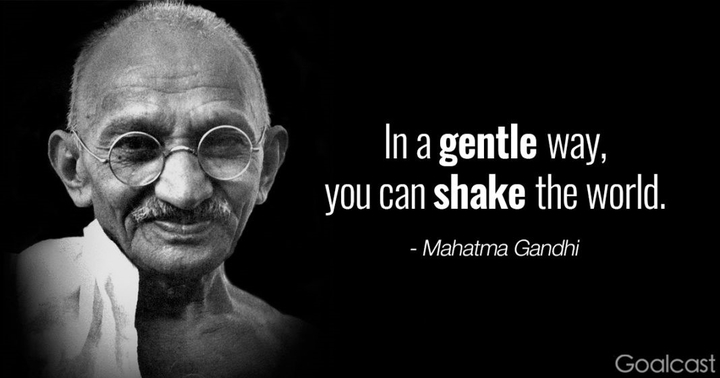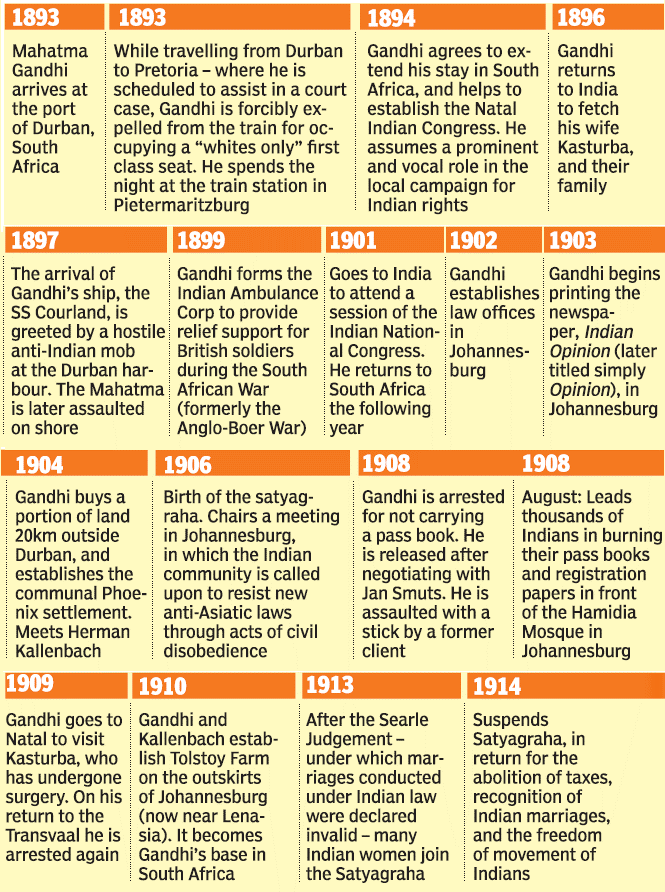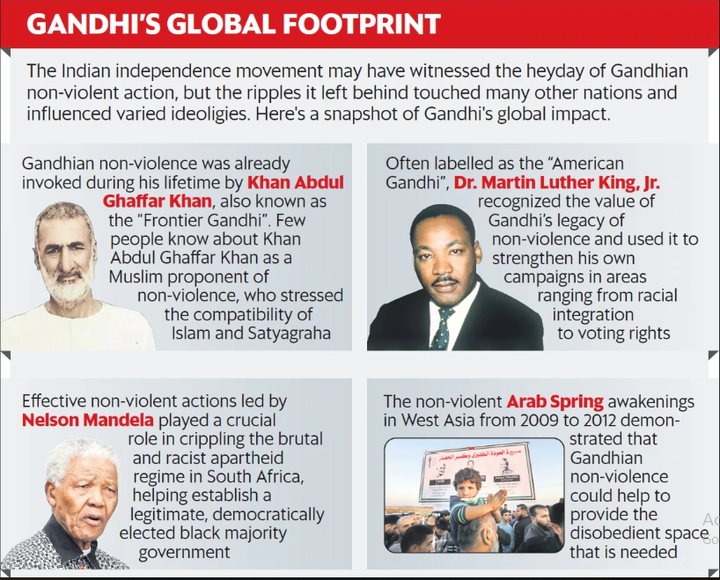Notes on Mahatma Gandhi
Mohandas Karam Chand Gandhi or Mahatma Gandhi is respected as the Father of the Nation by all the citizens of India, as he is the man behind India’s successful struggle for independence against the British rule in India. He also worked for the betterment of poor people in India. His ideologies of Satyagraha and non-violence have been guiding the entire world till now.
On 150th birth anniversary of Mahatma Gandhi, we are providing you with the details of his life which is equally important for all competitive examinations and for general knowledge.
Mahatma Gandhi
He was a well-known activist, political leader, lawyer, and author of various famous books like The Story of My Experiments with Truth, Hind Swaraj, Pathway to God, Constructive Programme its meaning and place, etc. His life has influenced many, and his ideologies have been adopted by various great leaders like Martine Luther King, Nelson Mandela, etc.

Earlier Life of Mahatma Gandhi
Basic Facts About Bapu | |
Father | Karam Chand Gandhi |
Mother | Putali Bai |
Wife | Kasturba Gandhi |
Children | Harilal Gandhi, Ramdas Gandhi, Manilal Gandhi and Devdas Gandhi |
Date of Birth | 2nd October 1869 |
Place of Birth | Porbandar, Gujarat |
Date of Death | 30th January 1948 |
Place of Death | Delhi, India |
Cause of Death | Assassination by Nathuram Godse |
He was born to Karam Chand Gandhi and Putali Bai (the fourth wife of Karam Chand Gandhi), on October 2nd, 1869 in Porbandar, Gujarat. His father was a diwan of Porbandar, which was the capital of one of the princely states of Western British India.
At the Nine years of age, he started his studies at Rajkot. Due to his marriage at the age of 13 with Kasturba Gandhi, he had to discontinue his studies for almost a year and later he joined and completed his schooling. Then he joined Sayamal Das College in Bhavnagar in 1888.
He was fascinated with the proposal of studying law in London, by a family friend Mavji Dave Joshi, and convinced his mother and wife to let him go. After his arrival to London, he joined Inner Temple, one of the four London Law Colleges where he studied and practised law.
In London, he also joined a Vegetarian Society. Some of his friends from the Vegetarian Society introduced him with Bhagwat Gita, which had a massive impact on his life. Studying in London provided him with the opportunity to mingle with people belonging to different religions and cultures. He developed a keen interest in reading philosophies of Leo Tolstoy, John Ruskin, and Henry David Thoreau.
After successful completion of his degree, he came back to India and attempted to practice law in Bombay. But, he could not succeed. After two years of struggle, in May 1893, he went to Natal, South Africa and started working as a legal counsel for an Indian merchant Dada Abdulla. In June 1893, while Gandhiji was travelling to Pretoria, Transvaal, he was thrown out off the first-class compartment of the train despite holding a valid ticket as it was reserved for Whites only and no Indians and blacks were allowed. This event impacted his life significantly.
In April 1894, when he was preparing to leave for India, his fellow Indians requested him to stay back in Durban and help them fight against the atrocities by the White Government. In May 1894, he established Natal Indian Congress to work for the rights of Indian in South Africa.
In 1907 the first time he used Satyagraha to oppose the Asiatic Registration Act (the Black Act). Mass protests were organized under the leadership of Gandhi. After seven years of protest, the Black Act was repealed in 1914. His mode of non-violent protests proved successful. In January 1915, Gandhi Ji returned to India.
Gandhi’s Return to India
After his return to India, he travelled throughout the country to have a better understanding of Indian masses and their issues. In May 1915, he established Sabarmati Ashram in Ahmedabad, Gujarat as a community centre where the life with truth and non-violence as the central ideology. This centre was shifted at the banks of the Sabarmati River in 1917.
He joined Indian National Congress under the guidance of his political mentor Gopal Krishna Gokhale. His political career in India got a push in 1917 with Champaran Satyagraha where the indigo farmers in Champaran, Bihar had to face hardships by the European planters. Gandhi joined the protest against the European planters by non-violent means. The British government had to thus, address the demands of the indigo farmers and withdraw the forceful methods of production.
Similarly in 1918 at Kheda, against the increased taxes and revenues in the famine-affected region of Kheda, Gujarat, Gandhi again did Satyagraha and again came out victorious. These events increased his popularity among the masses of India, and people started believing in his ideologies to fight against all the odds in life.

Gandhi and the Indian National Congress
In 1919, the massacre of Jaliawala Bagh happened where a meeting was held in Jaliawala Bagh at Amritsar to peacefully protest against the Rowlatt Act. Gandhi launched Non-Cooperation Movement in 1920 after the massacre to resist British rule in India in a non-violent way by renouncing the titles and awards given by the British government, boycotting government schools, colleges, courts, etc. and adopting swadeshi and khadi. The movement ended abruptly in February 1922 after the violence at Chauri-Chaura.
He introduced a series of reforms in INC. In 1922 Gandhi was arrested. In 1924 at the Belgaum session of INC Gandhi was elected as the President of INC. In 1928 in the Calcutta session, Gandhi warned the British government to free India within a year. On January 26th, 1930 INC celebrated Indian Independence, as per the proposal of 1929 Lahore session of INC.
On 12 March 1930, Gandhi launched the Civil disobedience Movement by marching to Dandi from Ahmedabad. There he broke the salt law to demand swaraj by boycotting foreign goods. It led to the first round-table conference in 1930 and the signing of Gandhi-Irwin pact in 1931. He also represented India in England in the second round-table conference. However, the meeting was a fail.
The British Government introduced Communal Award, which further divided Indian society. In opposition to the increasing conflicts between a society based on caste, Gandhi observed fast until death in 1932. This led to common elections for Hindus, Harijans and other backward categories having seats reserved for them.
During the World War-II, the British government promised to grant India freedom in return to their support during the war, but they betrayed India. This led to the launch of the Quit India Movement in 1942 in which Gandhi gave the slogan of ‘Do or Die.’ But, the partition of India was a great set back to Gandhi. He undertook fast until death on 15 January 1947, in order the stop communal violence.
Death of Gandhi
The people of both the communities turned against Gandhi, and a few of them wanted him to die. Thus, he was assassinated by Nathuram Godse, a Hindu nationalist and a member of Hindu Mahasabha on January 30th, 1948. He accused Gandhi of favouring Pakistan.

Comments
Post a Comment